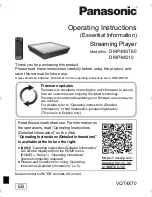
Glossary
Page A-8
Instruction Manual: evolution 5000 E5710 and E5720 Encoder
ST.TM.E10074.1
Program
PC - A sequence of instructions for a computer.
TV - A concept having a precise definition within ISO 13818-1 (MPEG-2). For a transport stream, the timebase is
defined by the PCR. The use of the PCR for timing information creates a virtual channel within the stream.
Programme
A linking of one or more events under the control of a broadcaster. For example, football match, news, film show.
In the MPEG-2 concept, the collection of elementary streams comprising the programme, have a common start
and end time. A series of programmes are referred to as events.
P
R
P
B
Analogue Colour difference signals. Refer to C
R
C
B
for an explanation.
PROM
Programmable Read-Only Memory:
A device, which may be written once with data for permanent storage, and
then read whenever required. Special types of PROM permit the erasure of all data by Ultraviolet light (EPROM) or
by application of an electronic signal (EEPROM).
PS
Program Stream:
A combination of one or more PESs with a common timebase.
PSI
Program Specific Information:
Consists of normative data, which is necessary for the demultiplexing of transport
streams and the successful regeneration of programs. (
See also:
SI).
PSIP
Program System Information Protocol:
The ATSC equivalent of SI for DVB.
PSK
Phase Shift Keying:
A method of modulating digital signals particularly suited to satellite transmission.
PSR
Professional Satellite Receiver: See also:
IRD.
PSU
Power Supply Unit.
QAM
Quadrature Amplitude Modulation:
A method of modulating digital signals, which uses combined techniques of
phase modulation and amplitude modulation. It is particularly suited to cable networks.
QPSK
Quadrature Phase Shift Keying:
A form of phase shift keying modulation using four states.
QSIF
Quarter Screen Image Format.
Quantise
A process of converting analogue waveforms to digital information. 8-bit quantisation as set out in ITU-R Rec. 601.
uses 256 levels in the range 0 – 255 to determine the analogue waveform value at any given point. The value is
then converted to a digital number for processing in the digital domain.
RAM
Random Access Memory:
A volatile storage device for digital data. Data may be written to, or read from, the
device as often as required. When power is removed, the data it contains is lost.
RAS
Remote Authorization System:
A TANDBERG TV proprietary public-key encryption system used to prevent
unauthorized viewing of a TV programme or programmes.
RF
Radio Frequency.
ROM
Read Only Memory:
A non-volatile storage device for digital data. Data has been stored permanently in this
device. No further information may be stored (written) there and the data it holds cannot be erased. Data may be
read as often as required.
RS
Reed-Solomon coding:
An error detection and correction, coding system. 16 bytes of Reed-Solomon Forward
Error Correction code are appended to the packet before transmission bringing the packet length to 204 bytes.
The 16 bytes are used at the receiving end to correct any errors. Up to eight corrupted bytes can be corrected.
RLC
Run Length Coding:
Minimisation of the length of a bit-stream by replacing repeated characters with an
instruction of the form ‘repeat character
x y
times’.
SCPC
Single Channel Per Carrier.
Spectral Scrambling
A process (in digital transmission) used to combine a digital signal with a pseudo-random sequence, producing a
randomised digital signal that conveys the original information in a form optimised for a broadcast channel.
Scrambling
Alteration of the characteristics of a television signal in order to prevent unauthorised reception of the information
in clear form.
SDT
Service Description Table:
Provides information in the SI stream about the services in the system; for example,
the name of the service, the service provider, etc.
SELV
Safety Extra Low Voltage (EN 60950).
STB
Set-Top Box:
A box that sits on top of a television set and is the interface between the home television and the
cable TV company. New technologies evolving for set-top boxes are video-on-demand, video games, educational
services, database searches, and home shopping. The cable equivalent of the IRD.
SFN
Single Frequency Network:
The SFN technique allows large
geographic areas to be served with a common
transmission multiplex. All transmitters in the network are synchronously modulated with the same signal and they
all radiate on the same frequency. Due to the multi-path capability of the multi-carrier transmission system
(COFDM), signals from several transmitters arriving at a receiving antenna may contribute constructively to the
total wanted signal. The SFN technique is not only frequency efficient but also power efficient because fades in the
field strength of one transmitter may be filled by another transmitter.
















































